Sciatica Relief & Causes
What is Sciatica?
Sciatica is a general diagnostic term used to describe radiating pain, numbness/tingling, or weakness that runs along the sciatic nerve. The pain typically starts in the buttocks or low back and shoots down into the leg. Typically, this pain is worse with extended periods of sitting and characterized as sharp shooting pain, as opposed to a dull achy pain.
Sciatica Causes
The sciatic nerve is the largest nerve in the human body that is comprised of several nerve roots that come together once they leave the spine. When a nerve root becomes impinged the irritation will radiate down the leg causing sciatica. The causes can vary. The most common cause is from a:
- Disc herniation or disc bulge.
- Another common cause is from spinal stenosis, which can be a result of degeneration or severe alignment issues.
- A condition known as piriformis syndrome is another common cause of sciatica that occurs from a tight and inflamed piriformis muscle impinging the sciatic nerve.
Figuring out the cause of sciatica is important in knowing how to treat the problem. Diagnosis typically includes a thorough examination using a range of motion testing, neurological evaluation, orthopedic testing, imaging with X-Rays or MRI, and further testing using Nerve Conduction Velocity and Electromyography.
Sciatica Treatment
Did you know chiropractic care can help relieve this pain?
Treatment can vary depending on the specific diagnosis, but the most common treatment is utilizing conservative care through chiropractic and physical therapy. Patients are typically put on a treatment plan that involves manipulation or mobilization of the spine to help take the pressure off the irritated nerve. This can be done using various techniques such as: Diversified technique, flexion-distraction, traction, and lumbar decompression. Active and passive stretches, like nerve flossing, can help benefit sciatica by releasing tension on the nerve root. Lastly, exercises should be prescribed to help strengthen the core and pelvic stabilizers. Strengthening these muscles will relieve excess pressure on the degenerating joints of the low back. In Severe cases, pain management or surgical intervention may be necessary.
For questions or to schedule please call (816) 272-3580, or you may schedule online.




Leave a Reply
Want to join the discussion?Feel free to contribute!